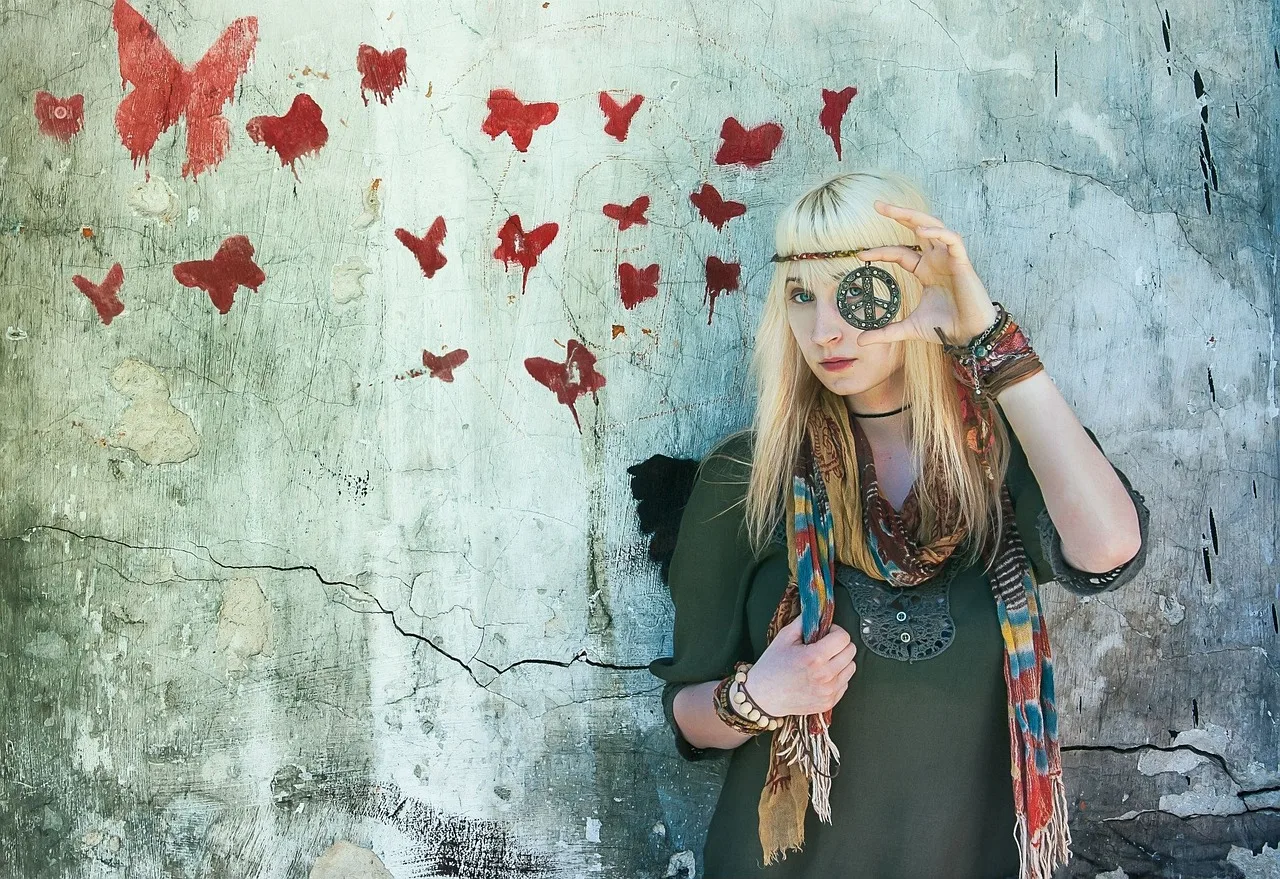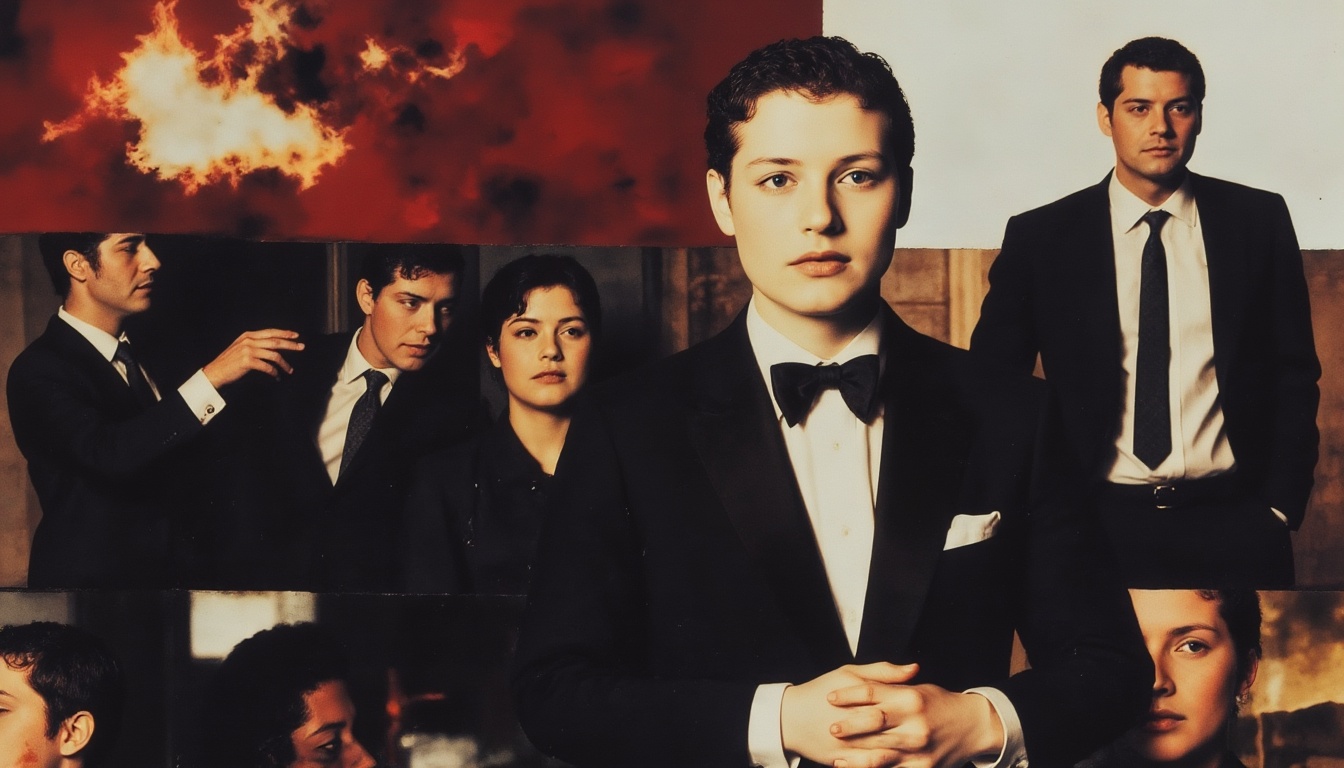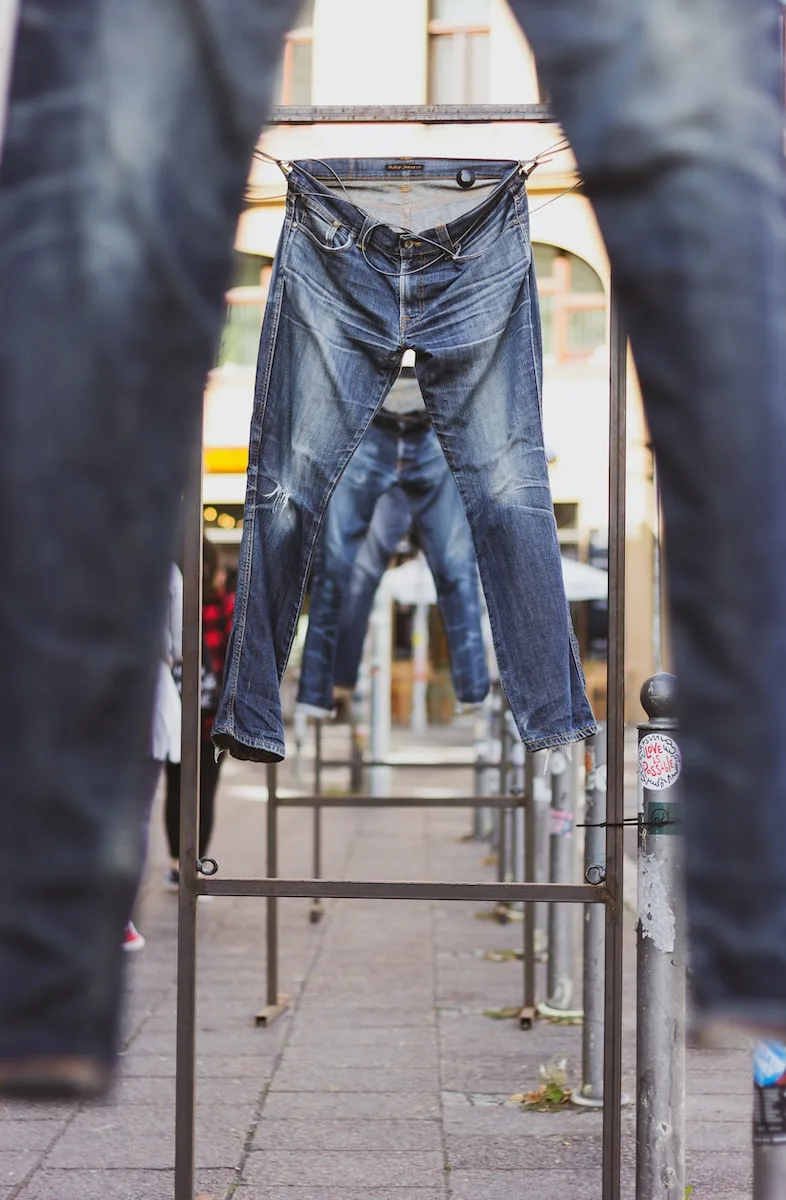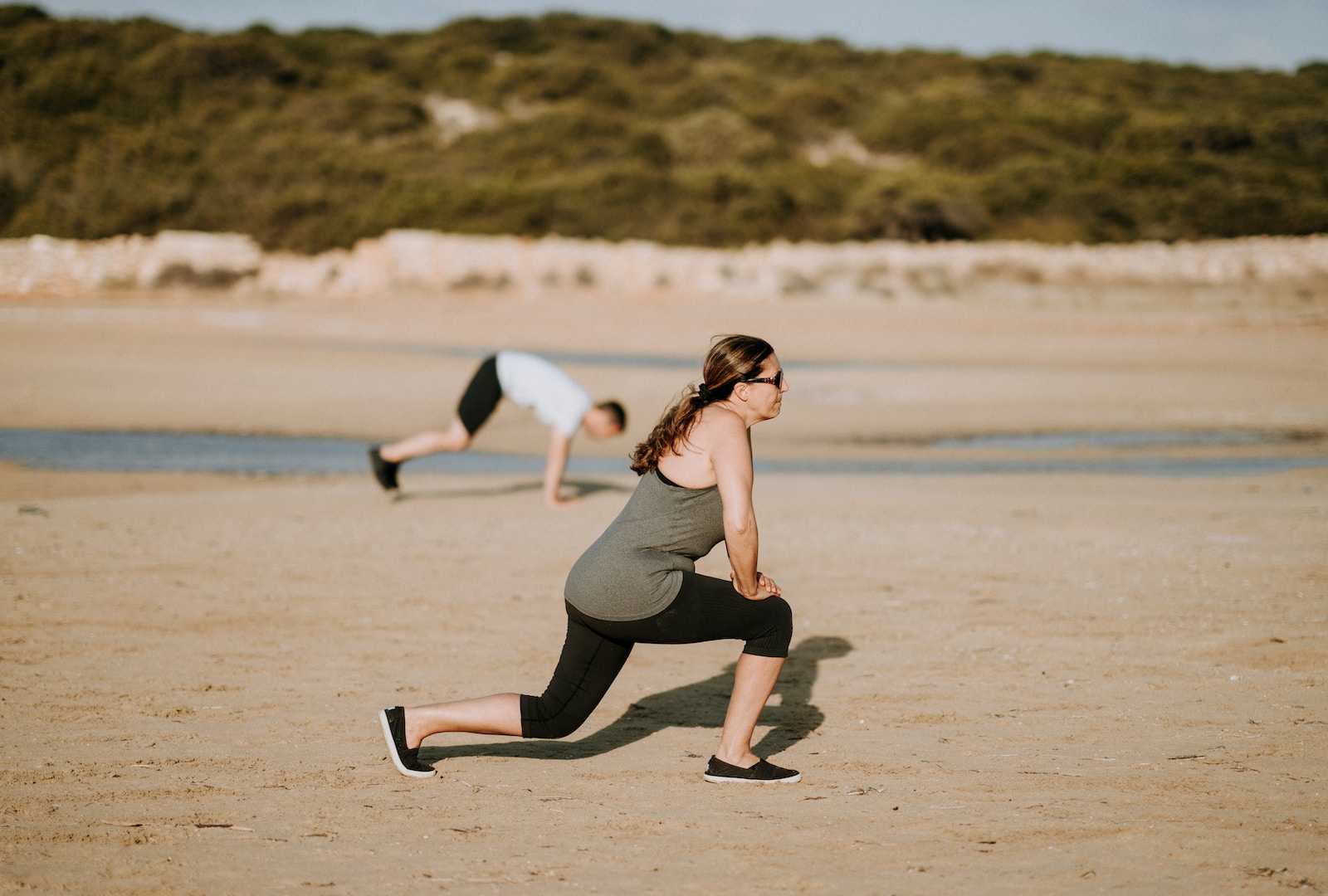Setting the Stage: The Bohemian and Hippie Chic
Every era births its unique fashion ethos and the 1960s were no exception. Two styles that came into prominence during this time have remained enduring: The Bohemian (Boho) and Hippie styles. Often conflated due to some overlapping elements, each style has its distinctive characteristics and resonates with a specific cultural ethos.
They’re far more than just fashion fads; they’re expressions of individuality, freedom, and creativity. Before diving into their nuances, it’s crucial to recognize that these styles did not appear ex nihilo.
They germinated from profound societal shifts occurring during their respective epochs. Understanding these roots allows for a more nuanced appreciation of the cultural significance embodied within every paisley print or floral motif.
Boho vs Hippie: Not Just a Fashion Fad
The Boho style’s charm lies in its romantic nod to the unconventional life led by artists, writers, musicians — essentially anyone who rejected bourgeois respectability for artistic pursuits. On the other hand, the Hippie movement was all about counterculture – peace protests, free love ideologies, and a revolutionary approach to living life.
Interestingly enough, both styles became popular because they flouted conventional norms — challenging established fashion canons by introducing an eclectic mix of colors, patterns and textures previously considered discordant or garish. Yet even as they both promote non-conformity in their own ways , they are distinct entities with their own trademarks that transcend periodic trends.
Historical Context: The Roots of Both Styles
The Boho style traces its roots back to mid-19th century France when artists started moving into low-rent Romani neighborhoods known as ‘bohemians.’ These impoverished yet creatively rich environs shaped a unique aesthetic marked by loose clothing from far-off lands – an aesthetic we know today as boho chic. The hippie style emerged from a powerful counter-cultural movement in 1960s America resounding with anti-war sentiment and calls for social reform. Its sartorial choices were markedly different from mainstream fashion – think psychedelic prints on bell-bottoms contrasting starkly with starched shirts and jackets of nuclear families on television screens!
The Bohemian Rhapsody: Unraveling the Boho Style
Definition and Origin: What Makes it ‘Boho’?
At its core, the term “Boho” is an abbreviation for “Bohemian,” which references the free-spirited, artsy inhabitants of the 19th century Parisian district named Bohemia. The Boho style is not just a sartorial choice, but a lifestyle that embraces creativity, freedom, and a disregard for conventional standards. It evolved into a unique fashion ensemble during the late 60s and early 70s as an anti-establishment reaction against traditional fashion.
The Boho style is defined by its multicultural aesthetic with influences from across different cultures around the world – from African tribal designs to Indian textiles, Turkish rugs to Chinese embroidery. It’s bold yet relaxed; complex yet uncomplicated in its unique way.
Key Features of Boho Style
Emphasis on Layering and Loose Fits
A hallmark of boho-chic style is its emphasis on loose-fitting layered garments such as maxi skirts, wide-legged trousers paired with tunics or cropped jackets, and flowy dresses complemented by oversized cardigans. This layering gives volume to outfits while maintaining an ease of movement that personifies carefree comfort. Mixing textures is another significant aspect – combining leather with lace or denim with chiffon creates visual interest without compromising comfort.
The aim? A look which has you floating through your day like a nomadic artist.
Love for Vintage and Handmade Items
A genuine boho wardrobe has more than just mass-produced fashion items – it’s peppered with vintage treasures and handmade elements. A delicate hand-knit shawl paired with grandma’s lacy dress or a vintage suede vest can add individuality to any outfit making each piece tell a story. Touched by human hands rather than machine made gives each item in your outfit unique authenticity – no two pieces are ever alike!
Floral Prints, Ethnic Patterns, and Earthy Tones Galore
Nature-inspired prints – especially floral ones – take center stage in boho dressing alongside ethnic patterns like tribal designs or Ikat prints. These symbols of natural beauty help create that signature whimsical bohemian vibe. The color palette leans heavily towards earth tones – think rich browns, deep burgundies, warm creams along with jewel tones like amethyst purple or emerald green providing splashes of vibrant color to light up any drab day!
Iconic Boho Fashion Figures: From Sienna Miller to Vanessa Hudgens
No discussion on boho chic would be complete without mentioning Sienna Miller who brought this eclectic look into mainstream fashion during the mid-2000s. Her knack for pairing effortless layers along with her love for vintage finds has made her one of the most influential modern-day proponents of this style.
Another celebrity icon who masters this trend seamlessly is Vanessa Hudgens whose Coachella attires always scream BOHO CHIC! Her penchant for bold prints mixed alongside one-of-a-kind accessories embodies everything we adore about this versatile look.
How to Rock the Boho Look Today
To recreate this timeless aesthetic today start by investing in some key pieces – oversized blouses or tunics in earthy hues accompanied by wide-leg pants or long flowing skirts are always trending plus they form great base layers! Add depth through accessories; chunky wooden jewelry adds an exotic flair while leather bags stamped with antique loom patterns bring forth global influences keeping true to that wanderlust spirit at heart.</p
Peace, Love, and Bell Bottoms: Understanding the Hippie Style
From Counterculture to Catwalk: What’s So ‘Hippie’ About It?
The term “hippie” often conjures images of peace signs, free love, and psychedelic music. However, the hippie movement was far more than a casual dalliance with cultural rebellion; it was an avant-garde social phenomenon that has significantly influenced contemporary fashion.
Emerging from the countercultural rebellion of 1960s America against political conservatism and societal norms, hippies embraced freedom in its every sense – even down to their sartorial style. Their attire became an expression of their ethos – individualistic, anti-establishmentarian and environmentally conscious.
Tie-dye shirts weren’t just colorful garments; they were vibrant symbols of resistance against mass-produced conformity. Likewise, bell-bottom pants were not merely a fad but rather a testament to nonconformity and freedom of movement.
The Canvas of Rebellion: Key Features of Hippie Style
Crucial to understanding hippie style is recognizing its key components – from psychedelic hues to natural textures. Each element carries a story steeped in history, adding depth and meaning beyond what meets the eye.
Dyeing for Change: The Tie-Dye Revolution and Psychedelic Patterns
The tie-dye technique became synonymous with the hippie aesthetic due to its DIY nature allowing individuals to create their unique patterns thus rejecting mass-produced fashion items. Furthermore, these designs were often psychedelic – kaleidoscopic swirls in bold colors that mirrored the mind-expanding experiences treasured by this community. This explosion of color wasn’t just visually intriguing; it reflected a break from monochromatic normativity symbolizing an exploration into new horizons of consciousness influenced by eastern philosophy and psychedelic substances like LSD.
Blossoming Resistance: The Flower Power – Floral Motifs in Abundance
Florals played a pivotal role in hippie aesthetics as well symbolizing peace (a flower was often placed in gun barrels during anti-war protests) therefore earning them the moniker “flower children”. This led to abundant use of floral motifs on clothing and accessories reinforcing an affinity towards nature coupled with notions of peace.
Ringing In Freedom: Bell Bottoms, Fringes, Headbands – Oh My!
Hippies expanded not only minds but also pant legs! Bell-bottom trousers represented liberation from restrictive clothing norms while being comfortable promoting easeful movements during spontaneous dance sessions or protests alike.
Similarly fringed jackets or vests added flair as well as represented Native American culture indicating a counter-cultural respect for indigenous communities contrasted against mainstream societal disregard. Headbands also rose prominently associated with both practicality (keeping flowing hair at bay) as well as subtle defiance denoting solidarity with war resistors who would traditionally fold bandanas around their heads.
Icons Against Conformity: Figures Who Embodied The Hippie Look
To fully understand how this countercultural revolution influenced fashion we can look at iconic figures such as Janis Joplin renowned for her gritty bluesy rock sound yet equally famous for her signature boho-hippie style blending luxe velvet pieces embroidered waistcoats layered beaded necklaces creating inspirational looks still echoed on runways today. Equally influential John Lennon his signature round glasses long hair have remained symbolic encapsulations epitomizing the quintessential ‘peace-loving’ hippie ideal embracing global influences reflected through Indian kaftans or military surplus clothing recontextualized amidst anti-war sentiment.
Channeling Your Inner Flower Child : How To Embrace Hippie Style Today
Today’s interpretation needn’t be cliched caricatures involving tie-dyed shirts flared jeans alone rather subtly incorporating elements exuding effortless comfort achieving chic boho-hippie crossover. Experiment with relaxed silhouettes embrace earthy tones while texture plays vital role layer crochet pieces over soft cotton dresses finish off leather sandals fringed bags bringing touch whimsy. Accessorize boldly making statement stacked bracelets long beaded necklaces headbands remembering embrace self-expression core foundation this trend remains authenticity power personal representation through attire
Intersection of Styles: When Boho Meets Hippie
The Confluence of Cultural Couture
When we delve into the intricacies of these two distinct fashion styles, it becomes all the more fascinating to witness their convergence. Both Boho and Hippie styles were born from social movements that emphasized unity with nature, spirituality, and freedom from societal norms.
Embodied in their clothing are stories of rebellion against conformity, an extraordinary love for the earth and its beauty, and a tenacious individuality that refuses to be subdued. Let us not neglect the fact that both these styles often share physical spaces – vintage stores, music festivals, artisan markets – where they blend seamlessly.
Observers may find it challenging to discern where Boho ends and Hippie begins or vice versa. This intermingling is not merely a coincidence but rather an indication of their common grounds.
Similarities Between Both Styles – More Than Meets The Eye
Harmonious Hues & Telling Textures
Both Boho and Hippie styles heavily draw inspiration from the earthy color palette. From deep forest greens to vibrant sunflower yellows and calming ocean blues– Nature’s hues are splattered generously across both these style spectrums. Both also share a penchant for varied textures including crochet, suede, denim, lace and more.
The love for patterns is another shared characteristic – florals find a place in both wardrobes as do bold ethnic prints inspired by various cultures around the world. An emphasis on comfort is evident in loose fits and flowing silhouettes—ideal for dance-filled fests or quiet introspective afternoons.
Distinctions That Set Them Apart
The Devil Is In The Detail: Distinguishing Between Bohemian & Beatnik Blends
Despite their similarities however, differences in execution make each style uniquely identifiable. Boho style leans towards sophistication; think maxi dresses with intricate prints or delicate lace inserts paired with gladiator sandals or wedges.
Jewelry tends to be plentiful yet tastefully layered—turquoise rings paired with simple silver bangles make for classic boho chic. Hippie style on the other hand has a distinctive casual air about it – Tie dyes are ubiquitous as are bell-bottom trousers and fringed vests which scream 60s counterculture.
Footwear is usually fuss-free; think comfy sandals or combat boots. While both have roots grounded deep within free-spirited ideals – one leans towards refined elegance while the other unabashedly embraces its raw rebellious energy.
Finding Your Fashion Footing in Boho and Hippie Styles
Having traversed the laid-back lanes of boho chic and the peace-loving paths of hippie style, it’s time to decide which lane beckons you more. But why pigeon-hole yourself into one category?
The beauty of fashion lies in its fluidity, its ability to be malleable. You could easily be swaying towards the bohemian vibe on Monday, adorned with layered clothing, vintage accessories and a relaxed silhouette that effortlessly speaks volumes about your free-spirited persona.
Yet, come Friday, you might find yourself gravitating towards the vivaciousness of hippie fashion. Basking in floral prints that echo an era of rebellion and love, complemented by bell bottoms that encapsulate the freedom of movement and thought celebrated by this counter-culture youth movement.
Boho-Chic or Flower-Child? Why Not Both?
Perhaps some days you’re more Sienna Miller than Janis Joplin. Or vice versa. Remember that these styles are not mutually exclusive but rather expressive spectrums of self-expression through fashion. Whether you resonate more with the earthy tones and whimsical layers characteristic of boho chic or find your spirit aligned with the bold prints and relaxed fits symbolic to hippie style – there’s no need for exclusivity when it comes to personal style. Flirt with both aesthetics; blend them in unique ways that are as eclectic as they are individualistic – just like these two trends themselves. After all, isn’t style an authentic reflection of who we truly are? So go on ahead – explore your boho side one day while letting your flower-child flag fly high another! In essence, whether you choose to tread down the bohemian path ornate with vintage delicacies or stroll through a hip field blossoming with flowers and tie-dye wonders – remember it’s all about expressing yourself in ways only fashion can translate eloquently!
Appendix: Your Eye-Catching Visual Guide
We now come to one of the most exciting sections of our exploration into Boho and Hippie styles: the visual guide. It is an old adage that a picture paints a thousand words, which we feel is especially true when discussing such rich, vibrant styles as Boho and Hippie.
This section will provide you with an array of images, creating a montage that encapsulates the essence of each style. First, let’s dive into Boho style.
Imagine loose-fitting flowy dresses in earth tones adorned with delicate floral prints, complemented by layers upon layers of unique jewelry and accessorized with wide-brimmed hats or intricate headbands. Picture vintage pieces from flea markets mixed with high-street fashion items for an eclectic mix that screams bohemian chic.
A Walk Through the Iconic Styles
Moving forward to our hippie style visual guide, think psychedelic tie-dye shirts paired with bell-bottom jeans or long flowing skirts. Imagine flower crowns mingling with fringed vests or leather jackets, alongside colorful beaded necklaces and round sunglasses for the quintessential hippie look. Don’t forget those iconic peace signs making frequent appearances!
Looking at these images side by side in our montage will give you a clear understanding of both styles’ unique aesthetics while highlighting their subtle overlaps. Whether it’s the love for natural elements, vintage influences, or eye-catching patterns – it’s no wonder boho and hippie fashion have stood the test of time!
Revisiting the Aesthetics: A Summation of Styles
In the course of this exploration, we’ve traipsed through the lush gardens of boho chic and danced barefoot in the fields of hippie style. We’ve admired their shared penchant for flowy fabrics, natural elements, and an overall sense of free-spiritedness.
However, it’s clear that while there is a common thread that weaves these two styles together, each has its own unique flair that sets them apart. The boho style is an artistic tapestry woven with threads borrowed from different cultures.
It champions layering, loose fits, vintage items and a generally unstructured silhouette. On the other hand, hippie style exudes an almost palpable air of love and peace with its vivacious tie-dye patterns, floral motifs in abundance and characterful bell bottoms.
Redefining Fashion: Breaking Stereotypes with Boho and Hippie Vibes
Both boho and hippie fashions are much more than just clothing styles – they represent movements and ideologies that have influenced generations. The counterculture ethos embedded in these styles continues to challenge conventional fashion norms by promoting comfort over couture, self-expression over societal expectations.
Dressing up in these styles is not about adopting a trend but about embodying a lifestyle – one where individuality reigns supreme. So whether you’re drawn toward the eclectic worldliness of boho or find yourself resonating with the peace-loving principles of hippie fashion – remember to embrace it wholeheartedly!
Recalling Iconic Figures: Paying Homage to Fashion Legends
As we look back at iconic figures who have championed these looks across decades; from Sienna Miller’s effortless Boho chic to Janis Joplin’s unabashedly vibrant Hippie style – it’s clear why these enduring fashion phenomena continue to captivate us even today. They remind us that fashion can be both personal expression and public statement; a visual symphony composed not just out what’s trending but also what’s meaningful. So whether you’re contemplating adding some tie-dye magic into your summer wardrobe or planning on channeling your inner Vanessa Hudgens with vintage-inspired pieces – remember that ultimately both Boho-Chic or Flower-Child vibes celebrate freedom – freedom to be yourself!
 Skip to main content
Skip to main content


